
In fluid dynamics, a stall is a reduction in the lift coefficient generated by a foil as angle of attack increases. This occurs when the critical angle of attack of the foil is exceeded. The critical angle of attack is typically about 15°, but it may vary significantly depending on the fluid, foil, and Reynolds number.

In flight dynamics a spin is a special category of stall resulting in autorotation about the aircraft's longitudinal axis and a shallow, rotating, downward path approximately centred on a vertical axis. Spins can be entered intentionally or unintentionally, from any flight attitude if the aircraft has sufficient yaw while at the stall point. In a normal spin, the wing on the inside of the turn stalls while the outside wing remains flying. It is possible for both wings to stall, but the angle of attack of each wing, and consequently its lift and drag, are different.
Visual flight or "Visual Attitude Flying" is a method of controlling an aircraft where the aircraft attitude is determined by observing outside visual references.

Aircraft flight control surfaces are aerodynamic devices allowing a pilot to adjust and control the aircraft's flight attitude.
In aeronautics, a descent is any time period during air travel where an aircraft decreases altitude, and is the opposite of an ascent or climb.
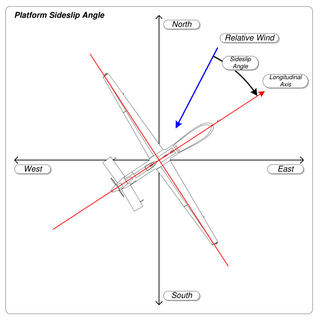
A slip is an aerodynamic state where an aircraft is moving somewhat sideways as well as forward relative to the oncoming airflow or relative wind. In other words, for a conventional aircraft, the nose will be pointing in the opposite direction to the bank of the wing(s). The aircraft is not in coordinated flight and therefore is flying inefficiently.
Spatial disorientation of an aviator is the inability to determine the altitude of the aircraft, meaning whether the craft is turning, ascending or descending. It is most critical at night or in poor weather, when there is no visible horizon, since vision is the dominant sense for orientation. The auditory system, vestibular system, and proprioceptive system collectively work to coordinate movement with balance, and can also create illusory nonvisual sensations, resulting in spatial disorientation in the absence of strong visual cues.
Retreating blade stall is a hazardous flight condition in helicopters and other rotary wing aircraft, where the retreating rotor blade has a lower relative blade speed, combined with an increased angle of attack, causing a stall and loss of lift. Retreating blade stall is the primary limiting factor of a helicopter's never exceed speed, VNE.

Air France Flight 296Q was a chartered flight of a new Airbus A320-111 operated by Air France for Air Charter International. On 26 June 1988, the plane crashed while making a low pass over Mulhouse–Habsheim Airfield as part of the Habsheim Air Show. Most of the crash sequence, which occurred in front of several thousand spectators, was caught on video. The cause of the crash has been the source of major controversy.

Basic fighter maneuvers (BFM) are tactical movements performed by fighter aircraft during air combat maneuvering, to gain a positional advantage over the opponent. BFM combines the fundamentals of aerodynamic flight and the geometry of pursuit, with the physics of managing the aircraft's energy-to-mass ratio, called its specific energy.
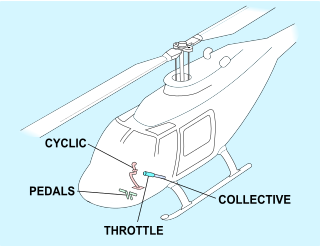
A helicopter pilot manipulates the helicopter flight controls to achieve and maintain controlled aerodynamic flight. Changes to the aircraft flight control system transmit mechanically to the rotor, producing aerodynamic effects on the rotor blades that make the helicopter move in a deliberate way. To tilt forward and back (pitch) or sideways (roll) requires that the controls alter the angle of attack of the main rotor blades cyclically during rotation, creating differing amounts of lift (force) at different points in the cycle. To increase or decrease overall lift requires that the controls alter the angle of attack for all blades collectively by equal amounts at the same time, resulting in ascent, descent, acceleration and deceleration.

A barrel roll is an aerial maneuver in which an airplane makes a complete rotation on both its longitudinal and lateral axes, causing it to follow a helical path, approximately maintaining its original direction. It is sometimes described as a "combination of a loop and a roll". The g-force is kept positive on the object throughout the maneuver, commonly between 2 and 3g, and no less than 0.5g. The barrel roll is commonly confused with an aileron roll.
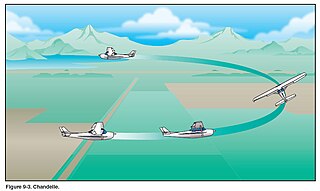
The chandelle is an aircraft control maneuver where the pilot combines a 180° turn with a climb.

On Friday, 24 June 1994, a United States Air Force (USAF) Boeing B-52 Stratofortress crashed at Fairchild Air Force Base, Washington, United States, after its pilot, Lieutenant Colonel Arthur "Bud" Holland, maneuvered the bomber beyond its operational limits and lost control. The B-52 stalled, fell to the ground and exploded, killing Holland and the three other field-grade officers on board the aircraft. In addition, one person on the ground suffered injuries during the accident, but survived. The crash was captured on video and was shown repeatedly on news broadcasts throughout the world.
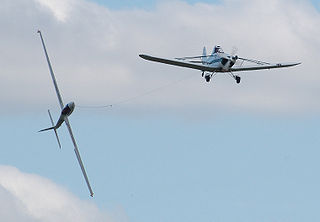
The aileron roll is an aerobatic maneuver in which an aircraft does a full 360° revolution about its longitudinal axis. When executed properly, there is no appreciable change in altitude and the aircraft exits the maneuver on the same heading as it entered. This is commonly one of the first maneuvers taught in basic aerobatics courses. The aileron roll is commonly confused with a barrel roll.

Alliance Air Flight 7412 was a scheduled Indian domestic passenger flight from Calcutta to Delhi, operated by Indian regional airliner Alliance Air. On 17 July 2000, while on approach to its first stopover in Patna, the Boeing 737-2A8 operating the route nose-dived and crashed into a residential area in Patna, killing 60 people including 5 on the ground.
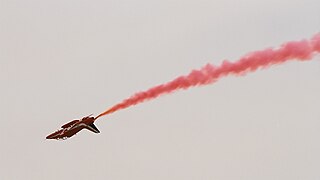
A slow roll is a roll made by an airplane, in which the plane makes a complete rotation around its roll axis while keeping the aircraft flying a straight and level flightpath. A slow roll is performed more slowly than an aileron roll; although it is not necessarily performed very slowly, it is performed slowly enough to allow the pilot to maintain balance, keeping a steady flightpath, pitch angle, and height (altitude) throughout the maneuver. The maneuver is performed by rolling the airplane at a controlled rate with the ailerons, and moving the elevators and rudder in opposition, or "cross-controlling," to keep the plane on a steady, level flightpath.
A wingover is an aerobatic maneuver in which an airplane makes a steep climb, followed by a vertical flat-turn. The maneuver ends with a short dive as the plane gently levels out, flying in the opposite direction from which the maneuver began.

A falling leaf is a maneuver in which an aircraft performs a wings-level stall which begins to induce a spin. This spin is countered with the rudder, which begins a spin in the opposite direction that must be countered with rudder, and the process is repeated as many times as the pilot determines. During the maneuver, the plane resembles a leaf falling from the sky; first slipping to one side, stopping, and then slipping to the other direction; continuing a side-to-side motion as it drifts toward the ground.
A power-off accuracy approach, also known as a glide approach, is an aviation exercise used to simulate a landing with an engine failure. The purpose of this training technique is to better develop one's ability to estimate distance and glide ratios. The variation in each angle refers to the degrees an aircraft must turn to be aligned with the runway. Consideration of the wind and use of flaps are important factors in executing power-off accuracy approaches.














